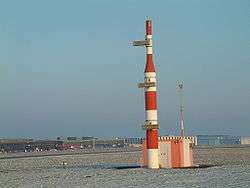Aeronautical radionavigation service


Aeronautical radionavigation service (short: ARNS) is – according to Article 1.46 of the International Telecommunication Union´s (ITU) Radio Regulations (RR)[1] – defined as «A radionavigation service intended for the benefit and for the safe operation of aircraft.»
This service is a so-called safety-of-life service, must be protected for Interferences, and is essential part of Navigation.
Classification
This radiocommunication service is classified in accordance with ITU Radio Regulations (article 1) as follows:
Radiodetermination service (article 1.40)
- Radiodetermination-satellite service (article 1.41)
- Radionavigation service (article 1.42)
- Radionavigation-satellite service (article 1.43)
- Maritime radionavigation service (article 1.44)
- Maritime radionavigation-satellite service (article 1.45)
- Aeronautical radionavigation service (article 1.46)
- Aeronautical radionavigation-satellite service (article 1.47)
Frequency allocation
The allocation of radio frequencies is provided according to Article 5 of the ITU Radio Regulations (edition 2012).[2]
In order to improve harmonisation in spectrum utilisation, the majority of service-allocations stipulated in this document were incorporated in national Tables of Frequency Allocations and Utilisations which is within the responsibility of the appropriate national administration. The allocation might be primary, secondary, exclusive, and shared.
- primary allocation: is indicated by writing in capital letters
- secondary allocation: is indicated by small letters
- exclusive or shared utilization: is within the responsibility of administrations
- Example of frequency allocation
| Allocation to services | ||
| Region 1 | Region 2 | Region 3 |
5 000–5 010 MHz
| ||
See also
References
- ↑ ITU Radio Regulations, Section IV. Radio Stations and Systems – Article 1.46, definition: aeronautical radionavigation service
- ↑ ITU Radio Regulations, CHAPTER II – Frequencies, ARTICLE 5 Frequency allocations, Section IV – Table of Frequency Allocations